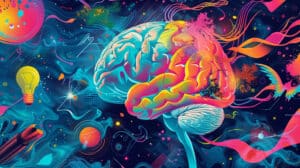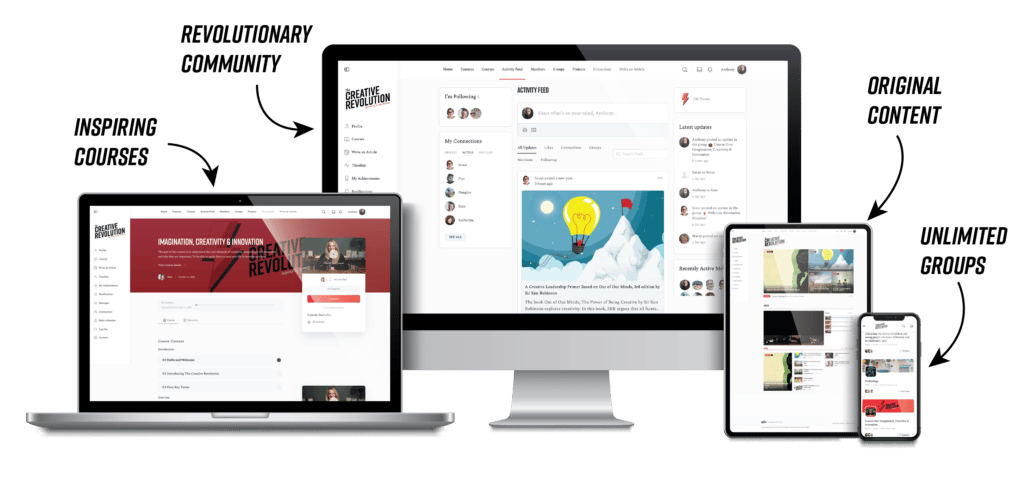This week the brilliant minds at We Are Cognitive (the studio who animated SKR’s RSA Animate and A Future for Us All) created and shared their version of a common simple aphantasia test above. It asks you to close your eyes and imagine an apple, then judge the clarity of the apple based on the scale of 1 – 5. If you score a 5, if you cannot see any apple at all but know you are thinking of an apple, then you might have a condition called aphantasia.
The Aphantasia Network defines the condition as “the inability to visualize. Otherwise known as image-free thinking.” They go on to say that “people with aphantasia don’t create any pictures of familiar objects, people, or places in their mind’s eye. Not for thoughts, memories, or images of the future.”
This means that people with aphantasia lack the ability to be visually imaginal – to bring to mind images of things they have previously experienced – and visually imaginative – to bring to mind images of things they have never experienced.
The important word to note here is “visually.” Aphantasia does not mean a complete lack of imagination, it means a lack of visual imagination.
What we know about imagination is that it exists on a spectrum. Like the rest of human intelligence, our capacity to imagine is unique to each of us. The organisation Imagination Spectrum identifies at least six different capacities of imagination, and we all have a unique blend of each. They are:
Visual Imagination – The ability to imagine pictures in your mind without actually seeing them with your eyes.
Auditory Imagination – The ability to imagine sound in your mind without actually hearing with your ears.
Olfactory Imagination – The ability to imagine smells in your mind without actually smelling with your nose.
Gustatory Imagination – The ability to imagine tastes in your mind without actually tasting with your tongue.
Tactile Imagination – The ability to imagine sensations in your mind without actually feeling with your body.
Motor Imagination – The ability to imagine movements in your mind without actually moving with your body.
People with aphantasia lack or have decreased capacity for the first, Visual Imagination, but not necessarily the other five. It is currently estimated that 2-5% of the population have aphantasia, and that about 26% of these people have “total aphantasia” or aphantasia that is multisensory, that affects all of their sensory imaginations.
Even for the very small percentage of the population that has total aphantasia, the condition does not mean they do not have imaginations. Imagination is a nuanced and complicated phenomenon. It allows us to bring to mind things that aren’t immediately present to our senses, and even without being able to do this in a sensory capacity the ability to imagine is still very much present.
The Aphantasia Network writes that “while this may seem puzzling at first glance, on reflection, imagination is a much richer and more complex capacity than the ability to visualize. Visualization enables most of us to picture things to some degree in our mind’s eye: imagination allows us to represent, reshape and reconceive things in their absence. Aphantasia illustrates the wide variety of types of ‘representation’ available to human minds and brains.”
Over the past several months I have spoken to a number of people with aphantasia, and almost all of them have said they were baffled to learn that other people can actually bring images to mind. They assumed that when people say “picture an apple” they mean it more metaphorically than literally. It goes to show just how universal we assume our experiences are, and brings back the mind scrambling question of “how do I know if my red is the same as your red?”
It’s worth noting that the people I have spoken to have self-diagnosed as having aphantasia. This is for several reasons: as aphantasia is an understudied area of neuroscience that has very little awareness surrounding it, formal testing is very rare. Also, our relationship with our imaginations is highly personal and subjective. No one knows your imagination except you, so who better to make a diagnosis. That said, if only 2-5% of the population have aphantasia, then either I know a disproportionate amount of people with the condition, or that percentage is far too low, or the “picture an apple” test is an oversimplification.
When I close my eyes I cannot picture an apple. When I close my eyes I see the inside of my eyelids. However, when I open my eyes and imagine an apple, I can bring one clearly to mind. I have very vivid daydreams, and yet struggle in any guided meditation to visualise the imagery prompts. If I was judging myself on the “picture an apple” test alone, I would absolutely diagnose myself with aphantasia, but I know that I don’t have it because in other circumstances I can bring clear images to mind. I also know that I panic in routine eye exams in case I give the wrong answer. When promoted to close my eyes and think of an apple I can’t make one appear on demand, but in the middle of the night when I can’t fall back to sleep, I can visualise all sorts of things (many I wish I hadn’t). The point is, our capacity to imagine is more nuanced than even our basic ability to imagine – circumstance, situation, interest, all play a role, in amongst other factors.
The Aphantasia Network suggests a more in-depth test called the Vividness of Visual Imagery Questionnaire to help diagnose aphantasia. This test is an extended version of the apple test, and is currently the next best step if you think you might have the condition. (It was created in 1975 and last updated in the 1990s, and so I do wonder if the huge advancements in neuroscience since the 1990s might make a more recent update to the test worthwhile).
Very interestingly, new research into aphantasia was released last year. A team of researchers from the University of New South Wales, Australia, studied the pupil dilation of their subjects. They found that when subjects were asked to visualize “dark” or “bright” mental images, the size of their pupils dilated. In fact, the study found that the vividness of someone’s mental imagery correlates with changes in pupil size or lack thereof. Those subjects with strong capacities for mental visualisation had larger pupils during the visualisation process than those without.
The study also looked at people with aphantasia and found that while subjects had normal pupil dilation when looking at bright or dark objects, their pupils stayed the same size during the mental visualisation exercises.
Aphantasia and Creativity
A common concern in the people with aphantasia that I have spoken to is whether or not the condition affects their ability to be creative. The answer is a resounding no. Having aphantasia does not show any correlation with decreased creative capacity. In fact, some highly successful, highly creative individuals have famously had aphantasia: Ed Catmull, co-founder of Pixar and former president of Walt Disney Animation Studios. Craig Venter, the biologist who first sequenced the Human Genome. Blake Ross, creator of Mozilla Firefox. Glen Keane, Disney Animator and Creator of The Little Mermaid. Penn Jillette of Penn and Teller.
Creativity is the process of having original ideas that have value. As we have discussed often on TCR, imagination is a key aspect in the creative process. Creativity is “applied imagination.” Not only have we established that aphantasia does not mean a lack of imagination, we also know that the creativity often thrives when presented with boundaries or obstacles to overcome. The human mind is inherently creative and adaptive.
What is so amazing about the human brain is just how much we still have to learn about it. As more awareness is brought to aphantasia, I am excited to learn even more about the spectrum of imagination. It goes to show once again just how important it is to connect with our own unique capacities of imagination and creativity, and to encourage each generation to do the same: we all bring something new to the table.
For more information and support surrounding aphantasia, check out the Aphantasia Network.
We will soon be speaking to Dr Amir Amedi for the Creative Revolution Podcast. Dr Amedi is a neuroscientist who has studied the neuroscience of imagination. If you have any questions you would like us to ask him about aphantasia, or any other aspect of imagination and neuroscience, please let us know below!




